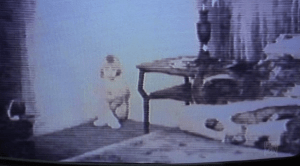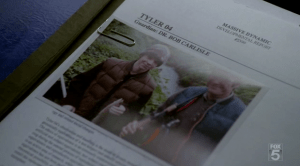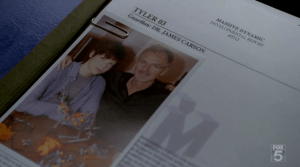 The Fox show “Fringe,” now in its third season, features FBI investigator Olivia Dunham (Anna Torv), mad scientist Walter Bishop (John Noble), and Walter’s wisecracking son Peter (Joshua Jackson, aka Pacey). Olivia works for a group inside the FBI called the “Fringe Division,” which investigates inexplicable happenings on the edges of rational knowledge. Walter, who had a brilliant career as a researcher at Harvard before he was institutionalized seventeen years prior to the beginning of the series, helps Olivia untangle the science of these happenings, often finding that his own earlier research has been used for ill. Peter is along for the ride, shepherding Walter, and acting as Olivia’s deputy, technical assistant, and, inevitably, love interest.
The Fox show “Fringe,” now in its third season, features FBI investigator Olivia Dunham (Anna Torv), mad scientist Walter Bishop (John Noble), and Walter’s wisecracking son Peter (Joshua Jackson, aka Pacey). Olivia works for a group inside the FBI called the “Fringe Division,” which investigates inexplicable happenings on the edges of rational knowledge. Walter, who had a brilliant career as a researcher at Harvard before he was institutionalized seventeen years prior to the beginning of the series, helps Olivia untangle the science of these happenings, often finding that his own earlier research has been used for ill. Peter is along for the ride, shepherding Walter, and acting as Olivia’s deputy, technical assistant, and, inevitably, love interest.
I love “Fringe” for many reasons, and sincerely hope that the recent announcement that the show will be moved into the Friday-night “death slot” doesn’t mean…well, death. The show’s constantly forcing its viewers to think harder about the advances of science and technology, and to question their ideas about what constitutes “progress.” As the narrative advances, we find out that many of the inexplicable events that the Fringe division investigates have been caused by a deteriorating boundary between this universe and its alternate—a boundary that may have been weakened by the overreaches of science. I love the show most of all because of the way that it recognizes childhood as a central theme in its exploration of the consequences of scientific and technological advancement. Like the young characters in fictions about post-nuclear childhoods that I reviewed a couple of weeks ago, the kids of “Fringe” are victims of science run amok; they stand in for “the public” or “the future” or “the innocent,” depending on the story line.
(Warning: The spoiler-averse should avoid this post.)
One of the best reasons to watch “Fringe” is Walter Bishop: a broken-down, brilliant, drug-addled man, whose curiosity often gets the better of him. Walter’s scientific interventions marred the childhoods of both Olivia and Peter, and their efforts to come to terms with his betrayals are at the root of some of the most interesting interactions of these characters. At the beginning of the series, Olivia believes that she is meeting Walter Bishop for the first time; in actuality, they met when she was a preschooler, and was enrolled in Walter’s trial of a nootropic drug called Cortexiphan. Walter and his partner William Bell believed that this drug could help the human brain reach a new level of power, and because they needed to test it on developing brains that had not yet been limited by culture, they used kids for their trials. Some of the subjects can ignite fires with their eyes, read the thoughts of others, control the actions of those around them through suggestion, etc. (It’s like X-Men, but these talents are drug-induced.) We first find out about Walter’s past connection with Olivia when we see Walter watching a chilling videotape of Olivia as a kid, huddled in a corner of his laboratory.
In one of my favorite episodes of the second season, “Jacksonville,” Walter, Olivia, and Peter go to Florida to visit the day-care facility where these tests took place.
Olivia remembers nothing about her time at the day care, but is clearly upset by seeing the facilities where the tests were carried out. Walter, on the other hand, experiences his return to the testing site as a flood of memories about a happier, more productive time in his life; at one point he takes a pair of his old eyeglasses out of a storage box, puts them on, and looks at himself in a shiny surface, grinning broadly.
Walter induces Olivia to take Cortexiphan again while in the facility, believing that this dose will regress her into a youthful state, and enable her to feel fear again. (That emotion is supposed to help her access the Cortexiphan-given power to identify objects that come from the alternate universe.) While under the influence of the drug, Olivia wanders around in a scary forest, and eventually finds a child: Olive. She tries to protect the girl, only to have her run away into the woods; when Olivia finally finds the kid and turns her around to find out if she’s hurt, we get a classic “freaky kid” scare frame.
The “Olive” of Olivia’s brain looks like she’s been possessed by a dark power. Because Olivia’s character is a reserved and buttoned-down one, this glimpse of a physical embodiment of the consequences of Walter’s betrayal is one of the most potent representations we get of Olivia’s resentment.
Walter’s inability to draw a line between his scientific curiosity and his ethical obligations also caused him to betray Peter. By the second season, we find out that when Peter was in middle childhood, he became very ill and died. Walter tried to find a cure, but figured it out too late. A grieving Walter created a window through which he could watch the Peter of the alternate universe. Eventually, he saw that this Peter was also dying; he breached the divide between universes to bring him back and cure him, intending to bring him back to his native side, but once she sees the other Peter, his wife won’t let him carry out his plans. Peter grows up in the wrong universe.
Walter is wracked with guilt about what he did to Peter—both because of the inherent wrongness of the thing, and because of the instability it created between the two universes. After Peter finds out about this history, near the end of the second season, he runs away in anger. In an episode from this story arc called “Brown Betty”, Walter smokes some strong marijuana, and then helps babysit Olivia’s niece Ella. The story he tells Ella, a noirish tale in which Olivia is a 1940s-style private eye hired to find Peter, forms the bulk of the episode. Walter himself, as the scientist who employs Peter, is the villain of the story; when the Olivia of the story finally finds Peter, he enlightens her about Walter’s true motives: “Walter’s invented a great many things. Wondrous things. That much is true. But what he didn’t tell you is where his ideas come from. Elephants, rainbows, licorice sticks… they come from the dreams of children. He steals children’s dreams and he replaces them with nightmares.” Peter shows Olivia a map he has studded with pushpins, each one standing in for a childhood that Walter has ruined.
Walter has many of the characteristics of “childishness” often present in depictions of mad scientists: he finds tiny things about the world fascinating; he follows his whimsy rather than planning rational courses of action; he eats large quantities of candy and pastries. It seems right that even in his guilt-driven fantasy his crimes are represented by a fanciful starfish made out of colorful pushpins.
The genius of the show is that what happened between Walter and Olivia and Walter and Peter is refracted and re-examined in many of the cases that the Fringe group tries to solve. Each episode of “Fringe” is meant to stand alone in a police-procedural kind of a way, while also developing the central questions of the show. Many of the episode-long arcs have child victims of science-out-of-control, as in “The Same Old Story” (s01e02), which is kicked off with the discovery of the body of a rapidly aging baby in a local hospital.
The team traces the crime back to a man who must inject hormones from pituitary glands in order to delay the effects of rapid aging. Walter remembers that he once worked on a research project for the U.S. Army, designed to produce quick-aging soldiers, and the agents eventually link that project with this series of events. In “The Abducted” (s03e07), the pituitary gland recurs as a plot device, as Olivia and the Fringe division in the alternate universe investigate a series of kidnappings by “the Candyman,” who returns his victims to their parents with a range of maladies common to old people: cataracts, cancer, bone weakness.
Then there’s the series of Tylers from “Of Human Action” (s02e07): a group of clones created by Massive Dynamic, William Bell’s cutting-edge corporate laboratory. As viewers, we don’t know until the end of the show that the young man who wreaks havoc through his ability to control the actions of others is actually a clone. Many of the “Tylers” were adopted by Massive Dynamic scientists, in an echo of Walter and Peter’s relationship.
Ben, who’s kidnapped in Season 1, Episode 8 (“The Equation”), was in a serious accident a few months prior, has become an expert pianist and composer since that trauma, which also killed his mother. Ben is obsessively working on a song; the notes turn out to be a musical representation of an equation that will enable humans to pass through solid matter.
Ben, the Tylers, the kids who had their pituitary glands drained—all represent echoes of Olivia’s and Peter’s childhood betrayals. On the episode of “The Fringe Podcast” released after “The Abducted”, hosts Darrell and Clint remarked that Olivia’s scenes with the child actors who play these victims are always very well-done, and credited actress Anna Torv for her work; I would argue that these scenes, which appear at the rate of one every two or three episodes, work so well because they’re functioning as tiny reminders of the past that ties Olivia, Walter, and Peter together.
Long live Fringe! Okay, I’m going to go sign a few “save-Fringe” petitions now.
On Friday: Watching “Weird Science” and “Zapped!”











tegan zimmerman
Jan 7, 2011 -
i just added season 1 to my netflix queue!
rebecca
Jan 7, 2011 -
Yes!! I wish I could watch it again from the beginning…jealousy. Let me know what you think…
Jody Alford
Jan 10, 2011 -
About half-way through season one, and loving it. I want more, now!! I didn’t want to spoil it for myself, so I stopped where you said “spoiler alert”. Thanks for the warning!
rebecca
Jan 10, 2011 -
Yes! So pleased to have convinced you to try it (if indeed it was my convincing that did it). Walter Bishop = the most entertaining mad scientist ever.